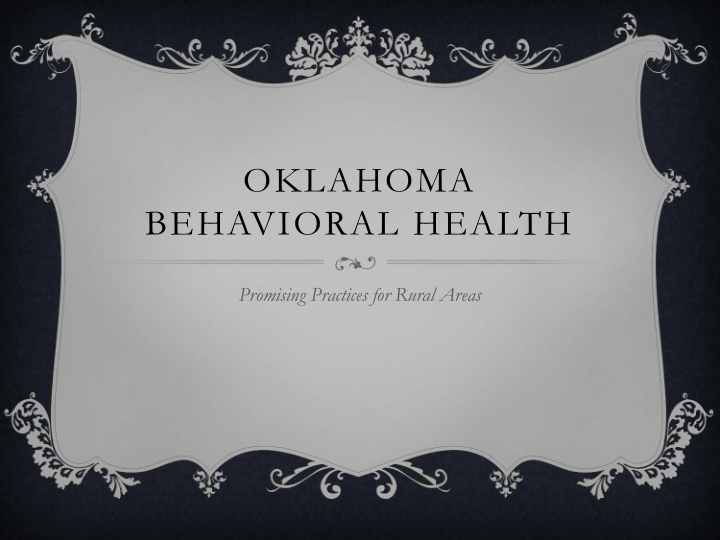



OKLAHOMA BEHAVIORAL HEALTH Promising Practices for Rural Areas
DEMOGRAPHICS
Oklahoma covers 68,667 square miles, with a 2011 estimated population of 3,791,508 people – 1,347,709 living in rural Oklahoma (USDA-ERS). There are 55 distinct Indian tribes that make the state their home, and each of these tribes has its own language or dialect. According to the U.S. Census Bureau, 75.8% of the state’s population is white, 8.9% is American Indian & Alaska Native, 7.7% Black/African American, 1.8% Asian, and 9.2% is of Hispanic/Latino origin (2011).
POPULATION BY AGE
According to the USDA Economic Research Service, the average per-capita income for Oklahomans in 2010 was $35,389, although rural per-capita income lagged at $31,512. 2010 estimates indicate a poverty rate of 18.8% exists in rural Oklahoma, compared to a 15.7% in urban areas of the state.
2010 ACS data reports that 17.3% of the rural population has not completed high school, compared to 13.1% of urban populations. The unemployment rate in rural Oklahoma is at 5.9%, while in urban Oklahoma it is 6.3% (USDA-ERS, 2011).
GENERAL HEALTHCARE
There are 113 hospitals in Oklahoma (Kaiser, 2010). The state has 34 hospitals identified by the Flex Monitoring Team as Critical Access Hospitals (December 2012).
There are 46 Rural Health Clinics in Oklahoma (Kaiser, 2012) and 17 Federally Qualified Health Centers provide services at 64 sites in the state (Kaiser, 2010). 8, 064 active PCP and Specialist Physicians (Kaiser, 2012) Psychiatry represents 9% of the specialty physician population, slightly below the national average of 10.8%.
Most Oklahomans have some form of health insurance, although 17.0% of its residents lack coverage (Kaiser, 2011). National data suggests that as parity for behavioral health coverage increases, provider reimbursement rates decrease. Reimbursement rates for rural providers do not account for geographical access barriers.
BEHAVIORAL HEALTH
RURAL VS. URBAN 20% of US population Rates of BH Experiences Quality of Services Access to services
BARRIERS TO TREATMENT Stigma and Cultural Issues Financing and Reimbursement Structural and Organizational Access and Workforce
RURAL OKLAHOMA WORKFORCE FINDINGS Staff Separations Vacancies and Staff Recruitment Barriers Current and Future Staffing Needs Benefits and Compensation Staff Work Experience and Job Satisfaction Workforce Capacity OKLAHOMA BEHAVIORAL HEALTHCARE WORKFORCE STUDY. 2011
E VID E N CE BASE D, BEST & PROMISING PRACTICES Evidenced Based Practices Best Practices Promising Practices Defining: Assess, implement, and measure, measure, measure. Meninger 2010
CHA R A CTER ISTICS OF SUCCESSFUL PROGR AMS FOR RUR AL COMMUNITIES Relevance to rural Impact on rural Sustainability and expansion capability Capacity Document of program information Effectiveness Community engagement
NATIONAL EVIDENCE BASED, BEST AND PROMISING PRACTICES BEST & PROMISING PRACTICES IN OKLAHOMA
Systems of Care • In 62 of 77 counties, the 15 counties that are awaiting services are in rural areas due partly to funding availability and community development. Programs for Assertive Community Treatment •Atoka • Cleveland • Coal • Comanche • Cotton • Garvin • Kay •Latimer • McClain • Murray • Oklahoma • Payne • Pittsburg •Pontotoc • Pottawatomi • Seminole • Tulsa Integrated Services Discharge Managers • Mabel Bassett • Lexington • McAlester
Trauma Focused Cognitive Behavioral Therapy • Free online tutorial available at http://tfcbt.musc.edu Seeking Safety Sanctuary program at Rose Rock Integrated Treatment: • Co-Occurring Treatment Specialists (COTS)
PROMISING CARE MODELS Tele-health • OKDMHSAS Collaborative, Coordinated and Integrated medical & behavioral health care • CareSouth Carolina Behavioral Health Department • Cherokee Health Systems • Shenandoah Valley Medical System
SERVICES IN MOST COUNTIES Medication Clinics Behavioral Health Case Managers Systems of Care and Wraparound Adult Drug Court Outpatient Therapy Rehabilitative services for children (private providers and CMHC’s) Tele-medicine (currently, mostly for medication management) Peer Support Services (provided by RSS)- all CMHC’s should have this
SERVICES AVAILABLE IN LIMITED NUMBER OF COUNTIES PACT Mental Health Court Juvenile and Family Drug Court CIT Police Officers (Crisis Intervention Teams) Substance Abuse Outpatient Substance Abuse residential Wellness Programs/Services
SERVICES AVAILABLE IN LIMITED NUMBER OF COUNTIES Detox (very limited for adults, nonexistent for youth School base services Evidence Based Practices (TF-CBT, CBT, PCIT, MI, Seeking Safety, etc) Community Based Structured Crisis Center (CMHC’s) (none for children) Mobile Crisis Teams (very limited) Homeless Outreach (PATH grant) Supported Employment
SE RVICE S IN AVAIL ABL E IN PIL OTS SITE OR SINGLE SITES ONLY FRE-Freedom Recovery and Empowerment Community Based Resource Coordination Supported Employment
S E RV I C E S A N D P R AC T I C E S N O T Y E T E S TA B L I S H E D A N D S U S TA I N E D I N RU R A L C O U N T I E S Program of Assertive Community treatment Parent Child Interactive Therapy Wraparound in 15 rural counties Crisis Center for Children Illness Management and Recovery Clubhouse Re-Entry Intensive Care Coordination Teams Family Drug Court (with one exception) Permanent supported housing
PROMISING CARE MODELS Tele-health • OKDMHSAS Collaborative, Coordinated and Integrated medical & behavioral health care • CareSouth Carolina Behavioral Health Department • Cherokee Health Systems • Shenandoah Valley Medical System
CHARGE TO GROUP Increase the accessibility of Behavioral Health services in Oklahoma Increase the quality of Behavioral Health Services in Oklahoma Questions?
USEFUL LINKS http://www.raconline.org/info_guides/rural/def http://www.raconline.org/states/oklahoma.php http://ruralhealth.okstate.edu http://okhca.org/research.aspx http://nrepp.samhsa.gov
PRESENTERS Brandy Brown, MSW Jeff Harlin, LCSW
Recommend
More recommend